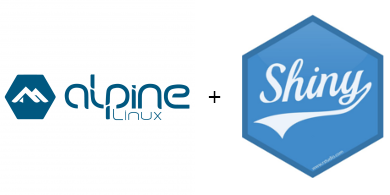Building a Repository of Alpine-based Docker Images for R, Part I

The Rocker Project maintains the official Docker images of interest to R users. I use their images as a base to deploy containerized Shiny apps, but the virtual size of the images I build tends to fall in the range between 400 and 600 MB. To reduce the size of my images, I decided to try building a Shiny Server on Alpine Linux as an alternative to Rocker’s Debian-based images. In this series of articles, I’ll document my progress from building a base image with R to building an image with Shiny Server. The Dockerfiles included in this article can be found at the velaco/alpine-r repository.
About Alpine Linux
Alpine Linux is a lightweight distribution that is popular for deploying containerized apps because the virtual size of an Alpine Docker image starts at 5 MB. The virtual size of images based on other distributions exceeds 100 MB before adding anything else to them, so Alpine achieves a significant reduction in size.
Some key differences between Alpine and other distributions that are relevant to my project are:
- Alpine uses musl lib as a lightweight alternative to glibc. That means precompiled installers built on platforms with glibc could be useless, even if I install libc6-compat or glibc packages for Alpine Linux.
- Alpine drops old versions of packages when new versions become available, making version pinning impossible, so I probably won’t be able to use nodejs and npm packages from the official repositories to build Shiny Server.
Because of those characteristics, I assume that building the images will require compiling most key dependencies from source. I’ve never done that before, so working on this project will be a great (and painful) learning experience.
Build from Native Packages
Building from source can often take up a lot of time, so I decided to start with the native packages to build a working image as soon as possible. Here is what my Dockerfile looked like:
FROM alpine:3.8
MAINTAINER Aleksandar Ratesic "aratesic@gmail.com"
# Declare environment variables ------------------
ENV LC_ALL en_US.UTF-8
ENV LANG en_US.UTF-8
ENV BUILD_DEPS \
cairo-dev \
libxmu-dev \
openjdk8-jre-base \
pango-dev \
perl \
tiff-dev \
tk-dev
ENV PERSISTENT_DEPS \
R-mathlib \
gcc \
gfortran \
icu-dev \
libjpeg-turbo \
libpng-dev \
make \
openblas-dev \
pcre-dev \
readline-dev \
xz-dev \
zlib-dev \
bzip2-dev \
curl-dev
# Install R and R-dev ------------------
RUN apk upgrade --update && \
apk add --no-cache --virtual .build-deps $BUILD_DEPS && \
apk add --no-cache --virtual .persistent-deps $PERSISTENT_DEPS && \
apk add --no-cache R R-dev && \
apk del .build-deps
CMD ["R", "--no-save"]
The resulting image has a virtual size of 136.4 MB. That’s an improvement in size compared to the rocker/r-base image, which is 277.4MB according to MicroBadger. However, I should mention that the rocker/r-base image includes some packages like litter that my Dockerfile doesn’t, so it has additional features that could be of interest to R users. (Not to mention that it is also more stable for use in production than my image.)
Build from Source Code
I recently learned that Alpine drops old versions of packages from the repository when new versions become available ( Source ). That means some versions of R won’t always be available from the official repositories, so I decided to create a Dockerfile for building R from source as well. I made the following changes to the previous Dockerfile:
- Declared environment variables for storing the R version and target directory for the source code.
- Added wget and tar to build dependencies for getting and unpacking the sources.
- Added libint and g++ to runtime dependencies. I learned that g++ is necessary for building from source after the first attempt raised an error while setting up the configuration options. The first container I started failed to run R because package libint was not installed, so I added it later.
- Removed the R-mathlib package from runtime dependencies. Rmath is installed as a standalone library from source in this image.
- Finally, I changed the RUN command accordingly to get, configure, and install R from source instead of adding the native packages.
This is what the final version of the file looked like:
FROM alpine:3.8
MAINTAINER Aleksandar Ratesic "aratesic@gmail.com"
ENV LC_ALL en_US.UTF-8
ENV LANG en_US.UTF-8
ENV R_VERSION 3.5.1
ENV R_SOURCE /usr/local/src/R
ENV BUILD_DEPS \
cairo-dev \
libxmu-dev \
openjdk8-jre-base \
pango-dev \
perl \
tiff-dev \
tk-dev \
wget \
tar
ENV PERSISTENT_DEPS \
libint \
gcc \
g++ \
gfortran \
icu-dev \
libjpeg-turbo \
libpng-dev \
make \
openblas-dev \
pcre-dev \
readline-dev \
xz-dev \
zlib-dev \
bzip2-dev \
curl-dev
RUN apk upgrade --update && \
apk add --no-cache --virtual .build-deps $BUILD_DEPS && \
apk add --no-cache --virtual .persistent-deps $PERSISTENT_DEPS && \
mkdir -p $R_SOURCE && cd $R_SOURCE && \
wget https://cran.r-project.org/src/base/R-3/R-${R_VERSION}.tar.gz && \
tar -zxvf R-${R_VERSION}.tar.gz && \
cd R-${R_VERSION} && \
./configure --prefix=/usr/local \
--without-x && \
make && make install && \
cd src/nmath/standalone && make && make install && \
apk del .build-deps
CMD ["R"]
The virtual size of the image it built was 311.6 MB, but it should be possible to reduce the image even further by cleaning up after building R. I didn’t want to do that yet because I still had to run the container and perform make check from the shell to test the installation.
There was one non-fatal error (raised by shownNonASCIIfile()) and two fatal errors raised by timezone.R and reg-tests-1c.R tests:
comparing ‘tools-Ex.Rout’ to ‘tools-Ex.Rout.save’ ... NOTE
--- /tmp/RtmpdpmEgM/Rdiffa445b3d67023
+++ /tmp/RtmpdpmEgM/Rdiffb445b7ac41733
@@ -796,8 +796,8 @@
> cat(out, file = f, sep = "\n")
>
> showNonASCIIfile(f)
-1: fa*ile test of showNonASCII():
-4: This has an *mlaut in it.
+1: fa<e7>ile test of showNonASCII():
+4: This has an <fc>mlaut in it.
> unlink(f)
>
>
.
.
.
running code in 'timezone.R' ...make[4]: *** [Makefile.common:105: timezone.Rout] Error 1
make[4]: Leaving directory '/usr/local/src/R/R-3.5.1/tests'
Sys.timezone() appears unknown
.
.
.
running code in 'reg-tests-1c.R' ...make[3]: *** [Makefile.common:105: reg-tests-1c.Rout] Error 1
make[3]: Leaving directory '/usr/local/src/R/R-3.5.1/tests'
make[2]: *** [Makefile.common:291: test-Reg] Error 2
make[2]: Leaving directory '/usr/local/src/R/R-3.5.1/tests'
make[1]: *** [Makefile.common:170: test-all-basics] Error 1
make[1]: Leaving directory '/usr/local/src/R/R-3.5.1/tests'
make: *** [Makefile:240: check] Error 2
According to the R Installation and Administration manual:
Failures are not necessarily problems as they might be caused by missing functionality, but you should look carefully at any reported discrepancies. (Some non-fatal errors are expected in locales that do not support Latin-1, in particular in true C locales and non-UTF-8 non-Western-European locales.)
Although the container runs R and has passed most tests, I wouldn’t feel confident using it in production or as a base for building Shiny Server because of the fatal errors. Therefore, this Dockerfile in the staging branch of my repository for now until those issues are fixed.
Next Steps
In R’s APKBUILD file I found the line
# TODO: Run provided test suite.
Because the R version installed from native packages was not tested, I have no reason to assume that is more reliable than my build from source. I am tempted to build Shiny Server on Alpine as soon as possible, and I will definitely make an attempt at building that image just to get an overview of the process. However, while I explore the process of building Shiny from Source, I will also focus on resolving the issues raised by the tests to create a reliable base image for Shiny.
Posted with : R, shiny, docker, alpine
